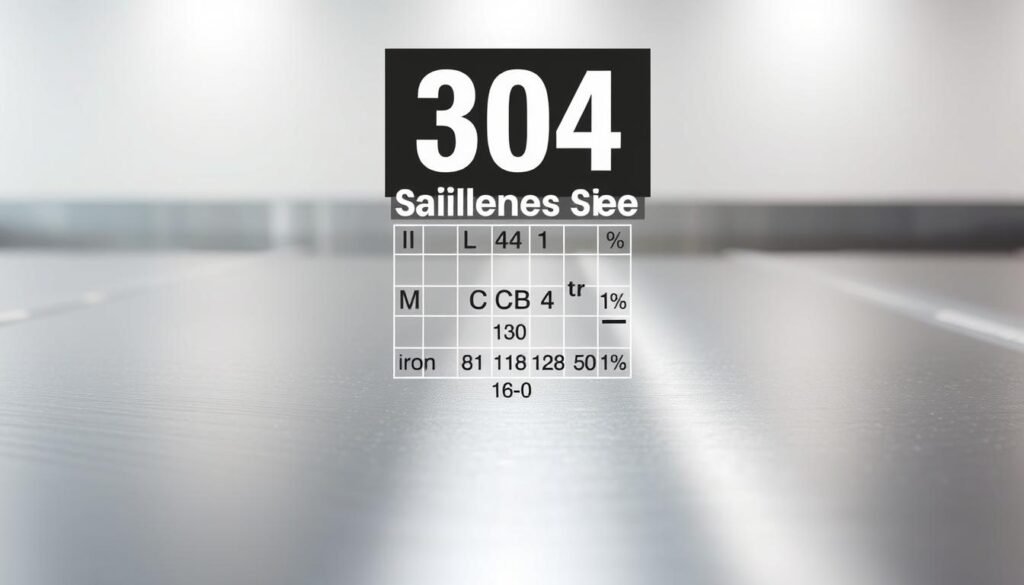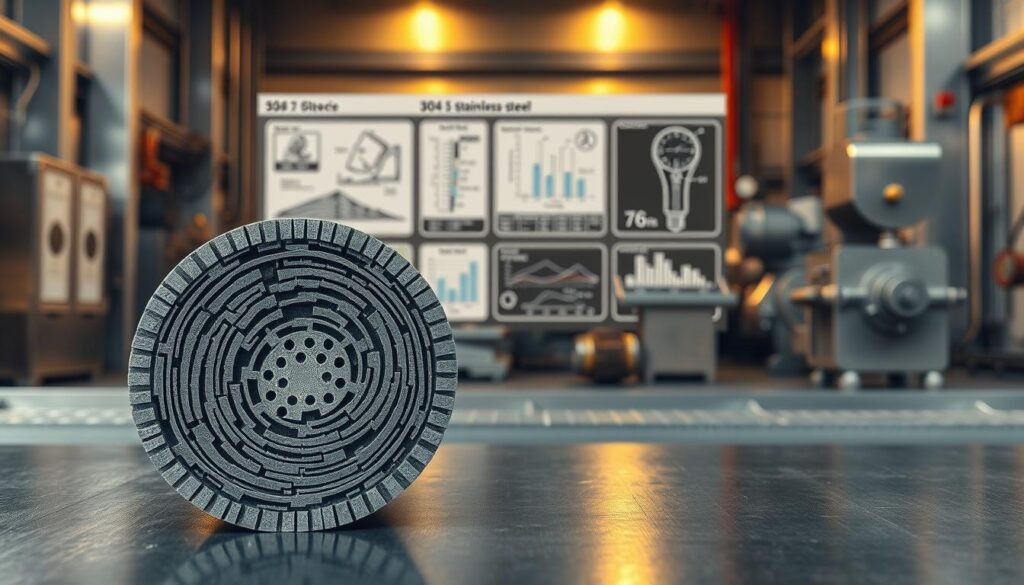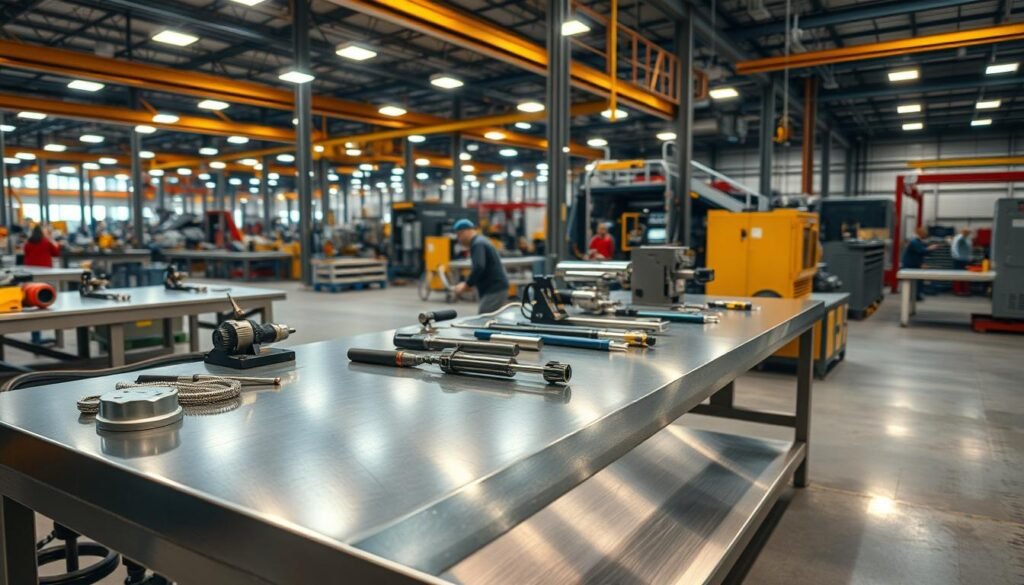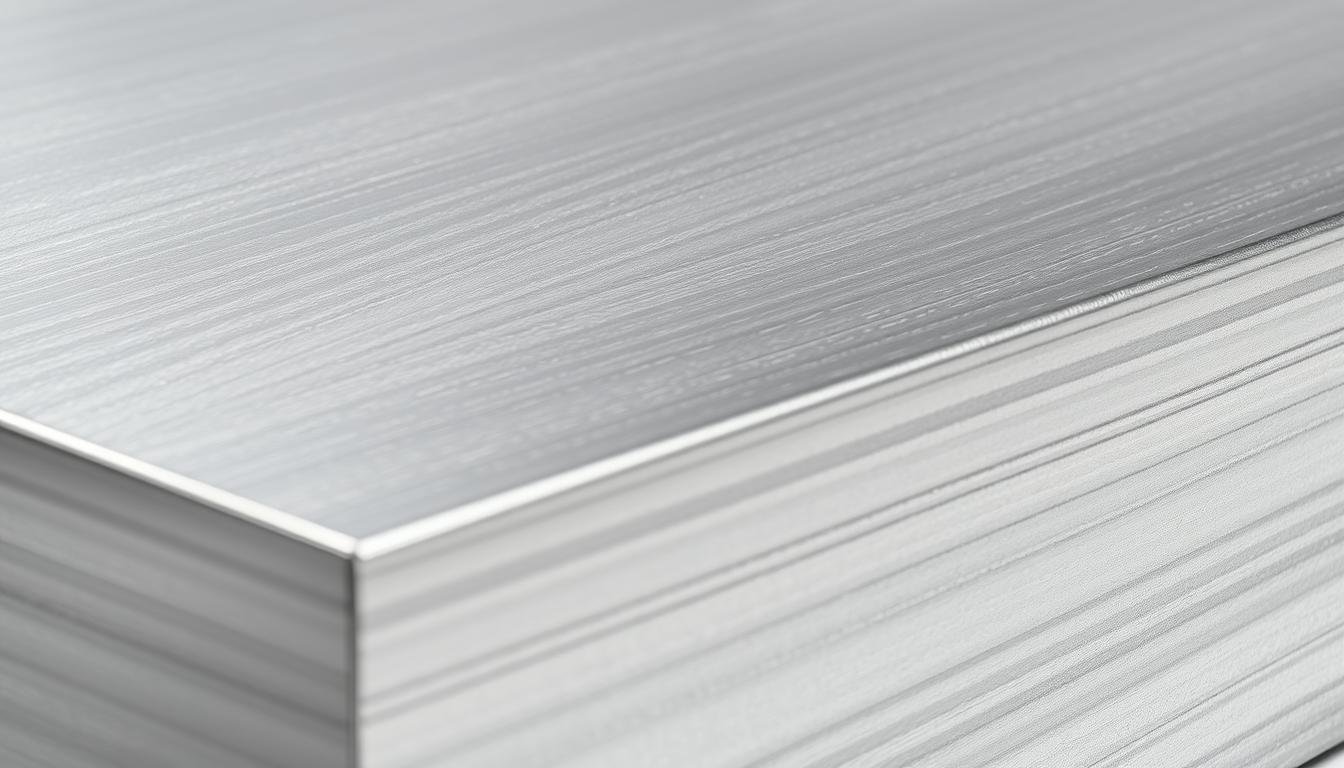In the world of manufacturing and construction, knowing the 304 stainless density is key. This material is strong, durable, and fights corrosion well. It’s a top pick for many industry applications.
We’ll explore the basics of 304 stainless steel. This will highlight its importance for those in the industry. Understanding its stainless steel properties helps make better choices. This leads to better project results and longer-lasting work.
Overview of 304 Stainless Steel
304 stainless steel is a versatile material used in many industries. It’s also known as 18/8 stainless steel. It has about 18% chromium and 8% nickel. This mix makes it an austenitic steel.
Its austenitic nature gives it great formability and weldability. These are key mechanical properties.
304 stainless steel also has excellent corrosion resistance. This makes it perfect for tough applications. It’s often used in kitchen appliances, sinks, and industrial equipment.
It’s a favorite in food processing and chemicals sectors. The qualities of 304 stainless steel ensure it lasts long and performs well. This makes it a top choice worldwide.
In short, 304 stainless steel’s unique mix and properties make it essential in industries that value quality, longevity, and safety.
Understanding the Chemical Composition
The chemical makeup of 304 stainless steel is key to its properties and performance. It has important alloy elements that make it stand out. Chromium (Cr) makes up 17.5 to 20% of the alloy, helping it resist corrosion by forming a protective layer. Nickel (Ni) adds 8 to 11%, boosting strength and flexibility.
Carbon (C) is capped at 0.08%, preventing it from becoming too sensitive during welding. Other alloy elements like manganese (Mn), silicon (Si), phosphorus (P), and sulfur (S) are also present. They help improve mechanical properties, making Grade 304 versatile for many uses.
A detailed look at the chemical composition of 304 stainless steel is shown below:
| Element | Composition Range (%) |
|---|---|
| C | 0.0 – 0.08 |
| Mn | 0.0 – 2.0 |
| Si | 0.0 – 1.00 |
| P | 0.0 – 0.045 |
| S | 0.0 – 0.03 |
| Cr | 17.5 – 20.0 |
| Ni | 8.0 – 11.0 |
| Fe | Balance |
| N | 0.0 – 0.11 |
These detailed chemical compositions show how the alloy elements work together. They make 304 stainless steel strong and reliable. For more information, check out this source.

304 Stainless Density and Its Importance
Knowing about 304 stainless density is key for many professionals. It shows how much the material weighs per unit volume. This helps us understand its strength and if it’s right for certain jobs. The density of 304 stainless steel is about 8.00 g/cm³, which greatly affects its durability.
Definition of Stainless Density
Stainless density is the material’s mass divided by its volume. For 304 stainless steel, this number is very important. It helps decide if the material is good for a particular use. A higher density usually means the material is stronger, which is important for design and engineering.
Impact on Material Performance
The density of 304 stainless steel has big effects. A higher density means the material is more rigid and stable. This makes 304 stainless steel great for jobs where things are stressed or the environment changes a lot. Knowing how density affects material performance is key to making sure things last a long time.
| Property | Value |
|---|---|
| Density | 8.00 g/cm³ |
| Typical Applications | Food processing, automotive, construction |
| Impact on Performance | Increased strength and stability |
Mechanical Properties of Grade 304 Stainless Steel
Grade 304 stainless steel has key mechanical properties that make it great for many uses. It has high tensile and yield strength, making it strong for both heavy and precise tasks. Its elongation and hardness also add to its versatility and dependability.
Tensile and Yield Strength
Grade 304 stainless steel has a minimum tensile strength of 515 MPa. This means it can handle a lot of pulling without breaking. Its yield strength of 205 MPa lets it take a lot of stress before deforming. These strengths help Grade 304 keep its shape and structure under stress.
Elongation and Hardness Characteristics
Grade 304 stainless steel also has a high elongation of 40% in a 50 mm sample. This makes it easy to shape without breaking. Its Rockwell B hardness of 92 shows it’s tough and can resist scratches and dents. These properties make it a top choice for many applications needing strength and flexibility.

Corrosion Resistance of 304 Stainless Steel
Grade 304 stainless steel is known for its excellent corrosion resistance. This makes it useful in many different situations. The high chromium content in the alloy forms a protective layer.
This layer stops rust and makes the material last longer. It works well in many conditions and with many corrosive chemicals.
How Corrosion Resistance is Achieved
The protective layer forms when chromium reacts with oxygen. It acts as a shield against moisture and corrosive agents. The more chromium, the better the protection.
Keeping the right mix of nickel, manganese, and other elements also helps. This makes Grade 304 good for various environments.
Limitations in Chloride Environments
Grade 304 is very resistant to corrosion, but it’s not perfect. In places with lots of chlorides, like near the sea or in industrial areas, it can corrode. This can cause pitting and crevice corrosion.
So, choosing the right material is key in these areas. Engineers might choose Grade 316 instead. It’s better suited for places with lots of chlorides.
Applications of 304 Stainless Steel in Industries
304 stainless steel is used in many industries because of its great properties. It’s strong, resistant to corrosion, and looks good. This makes it key in food processing and architecture.
Food and Beverage Processing
This alloy is top for food processing. It keeps food safe by not reacting with it. This means flavors and contaminants don’t mix.
Things like tanks, pipelines, and utensils are made from it. They can handle high temperatures and harsh cleaners. It’s also easy to clean, helping keep food production clean.
Architectural and Construction Uses
In architecture, 304 stainless steel is great for looks and function. It’s used in building facades, railings, and more. Its resistance to corrosion means it lasts long outside.
The shiny finish of 304 stainless steel looks good. It’s perfect for places where looks matter a lot.
| Application Area | Key Benefits | Common Uses |
|---|---|---|
| Food and Beverage Processing | Non-reactive, easy to clean, temperature resistant | Tanks, pipelines, utensils |
| Architecture | Corrosion resistant, aesthetic appeal, durable | Building facades, railings, structural components |
Comparative Analysis with Other Stainless Steel Grades
When we look at stainless steel grades, two stand out: Grade 304 and Grade 316. Knowing the differences between them helps us understand their uses.
304 vs. 316 Stainless Steel
316 stainless steel has molybdenum, which boosts its fight against corrosive stuff like saltwater and chlorine. This makes 316 great for places near the sea or where chemicals are around a lot. On the other hand, 304 is cheaper but works well in kitchens, appliances, and tanks. It’s easy to keep clean and affordable, making it popular in many places.
Advantages of 304 Over Other Alloys
304 stainless steel is a good mix of being affordable and doing the job well. It’s chosen often because it’s easy to shape and weld. The advantages of 304 make it a favorite for many uses, from food to building.
Fabrication and Processing Flexibility
304 stainless steel stands out for its flexibility in fabrication and processing. It’s perfect for many industries because of its versatility. This material can be shaped and welded in various ways, fitting different projects.
Welding Techniques
304 stainless steel is very weldable, making it a favorite for many uses. You can use several welding methods, like:
- MIG welding
- TIG welding
- Spot welding
This material can be welded easily, without needing a lot of work after welding. This is great for projects that need to be put together quickly. It shows how flexible 304 stainless steel is.
Forming Capabilities
304 stainless steel is very ductile, making it easy to shape and bend. It can be deep drawn without needing to anneal it first. This makes it perfect for things like:
- Sinks
- Cookware
This flexibility in processing helps meet many design needs. From industrial parts to everyday items, 304 stainless steel is a top choice. Its strong manufacturing abilities make it a go-to for many industries.

Conclusion
The 304 stainless steel summary shows its top-notch mechanical properties and great corrosion resistance. It also has excellent processing flexibility. These qualities make Grade 304 a top choice in many industries.
Its use in different fields, from food processing to architecture, shows its wide appeal. This makes it a key material in various projects.
Choosing 304 stainless steel means getting benefits like longer-lasting projects and better looks. It also improves performance. Knowing its unique qualities helps professionals make the most of it for their projects.
Grade 304 stainless steel is more than just a material. It’s a smart choice that boosts project success. Its importance in today’s infrastructure and design is clear. It’s a must-have in many industries.
